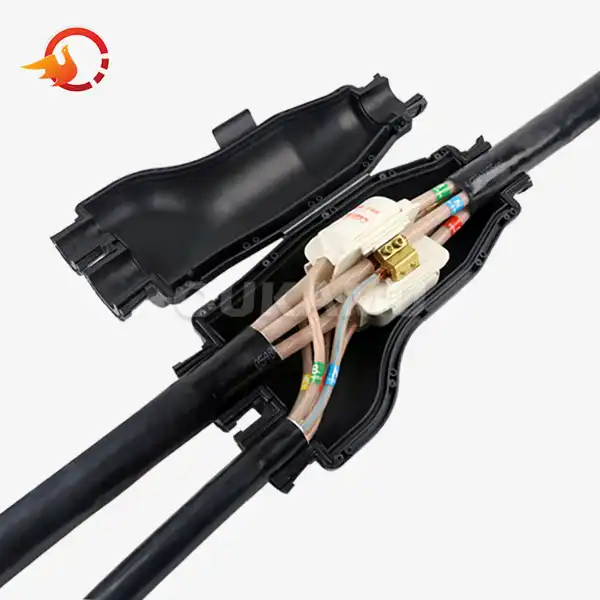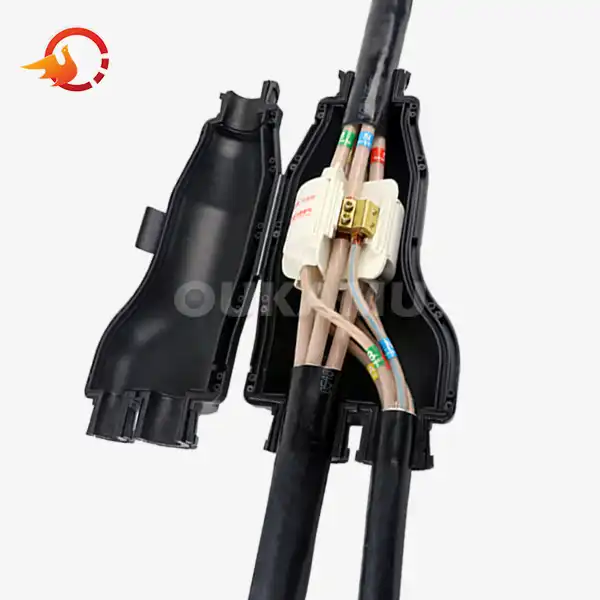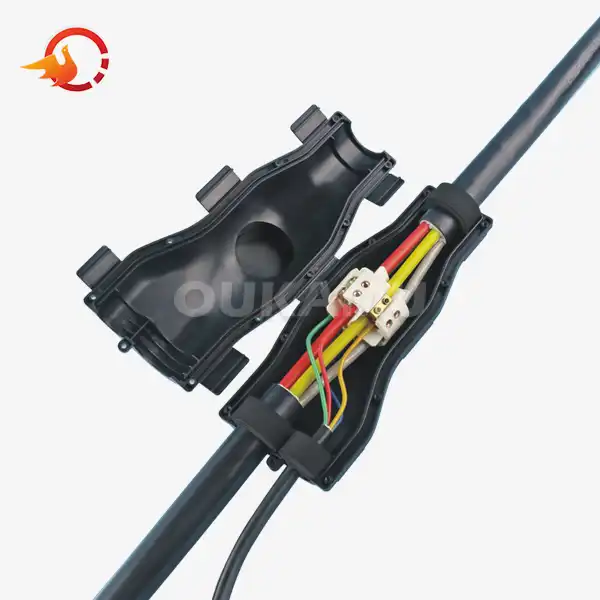Low Voltage Waterproof Joint for Main and Branch Cables
 2025-04-30 09:00:32
View:389
2025-04-30 09:00:32
View:389In the realm of electrical infrastructure, the importance of reliable cable connections cannot be overstated. Low voltage waterproof straight-through joints for main and branch cables have emerged as a game-changing solution, offering unparalleled safety, efficiency, and cost-effectiveness. This article delves into the world of these innovative connectors, exploring their features, benefits, and applications.
Understanding Low Voltage Waterproof Joints: A Revolutionary Cable Connection Solution
Low voltage waterproof joints represent a significant advancement in cable connection technology. These joints are designed to seamlessly connect main cables with branch cables while providing robust protection against water ingress and environmental factors. Unlike traditional methods that often require cutting the main cable, these joints allow for non-invasive installation, preserving the integrity of the primary line.
Key Features of Low Voltage Waterproof Joints
Several features make these joints stand out in the electrical infrastructure landscape:
- IP68 Waterproof Rating: This rating ensures complete protection against dust and long-term water immersion, making these joints suitable for underground and outdoor installations.
- Versatile Cable Compatibility: Typically accommodating main cables of 10-35mm diameter and branch cables of 2.5-16mm diameter, these joints offer flexibility in various applications.
- Gel-filled Insulation: The use of gel-filling technology provides superior insulation and waterproofing, offering a double layer of protection.
- Concealed Installation: These joints can be installed in wells or directly buried in soil, allowing for discreet and space-saving implementations.
- No Cable Cutting Required: The ability to install without cutting the main cable eliminates the need for length reservations and simplifies the installation process.
The Technology Behind Waterproof Joints
At the heart of these low voltage waterproof straight-through joints lies advanced polymer technology. The materials used are carefully selected for their dielectric properties, mechanical strength, and resistance to environmental degradation. The gel-filling, often a proprietary blend, not only provides excellent insulation but also has self-healing properties, ensuring long-term reliability even in challenging conditions.
Benefits and Applications of Low Voltage Waterproof Joints
The adoption of low voltage waterproof joints brings a multitude of benefits to electrical infrastructure projects:
Cost-Efficiency and Time Savings
By eliminating the need for cable cutting and complex splicing, these joints significantly reduce installation time and labor costs. The ability to make on-site adjustments also minimizes material waste, contributing to overall project cost reduction.
Enhanced Safety and Reliability
The waterproof and dustproof nature of these joints enhances the safety of electrical installations. The risk of short circuits, electrical fires, and electrocution is greatly reduced, especially in environments prone to moisture or flooding.
Flexibility in Design and Installation
These joints offer unparalleled flexibility in cable layout design. Engineers can adjust branch positions on-site, adapting to unforeseen obstacles or changes in project requirements without the need for extensive replanning or cable replacement.
Durability and Longevity
Designed to withstand harsh environmental conditions, including exposure to chemicals, UV radiation, and temperature fluctuations, these low voltage waterproof straight-through joints ensure a longer lifespan for the entire cable network, reducing maintenance needs and replacement frequency.
Applications Across Various Sectors
Low voltage waterproof joints find applications in numerous sectors:
- Urban Infrastructure: Street lighting, traffic signal systems, and public space electrical networks.
- Industrial Facilities: Factory floor electrical distributions, outdoor equipment connections, and temporary power setups.
- Renewable Energy: Solar farms and wind turbine installations, where outdoor exposure is constant.
- Transportation: Railway signaling systems, airport runway lighting, and highway infrastructure.
- Marine Environments: Dock and harbor electrical systems, offshore platforms, and seaside installations.
Installation and Maintenance: Best Practices for Optimal Performance
While low voltage waterproof joints are designed for ease of use, following best practices during installation and maintenance is crucial for ensuring optimal performance and longevity.
Installation Guidelines
Proper installation is key to harnessing the full benefits of these low voltage waterproof straight-through joints:
- Site Preparation: Ensure the installation area is clean, dry, and free from debris.
- Cable Preparation: Carefully strip the cable insulation according to the joint specifications, avoiding nicks or cuts in the conductor.
- Joint Assembly: Follow the manufacturer's instructions meticulously, paying special attention to the tightening of connectors and the application of insulating gel.
- Sealing: Ensure all seals are properly engaged and the joint is completely closed to maintain its waterproof integrity.
- Testing: Conduct insulation resistance and continuity tests before energizing the system.
Maintenance and Inspection
Regular maintenance ensures the continued reliability of the joint:
- Visual Inspections: Periodically check for signs of physical damage, water ingress, or corrosion.
- Thermal Imaging: Use thermal cameras to detect any hotspots that may indicate loose connections or insulation breakdown.
- Insulation Testing: Conduct regular insulation resistance tests to ensure the joint maintains its dielectric properties.
- Documentation: Keep detailed records of installation dates, maintenance activities, and any observed issues for each joint.
Troubleshooting Common Issues
While rare, issues can occur. Common problems and their solutions include:
- Water Ingress: If moisture is detected, the joint may need resealing or replacement.
- Loose Connections: Retightening of connectors may be necessary if voltage drop or heating is observed.
- Insulation Degradation: In cases of severe environmental exposure, the entire joint may need replacement.
Future Trends and Innovations
The field of low voltage waterproof joints continues to evolve. Emerging trends include:
- Eco-friendly Materials: Development of biodegradable or recyclable components to reduce environmental impact.
- Enhanced Thermal Management: Innovations in heat dissipation to allow for higher current-carrying capacities.
- Modular Designs: Joints that can be easily upgraded or modified to accommodate future network expansions.
Conclusion
Low voltage waterproof straight-through joints for main and branch cables represent a significant advancement in electrical infrastructure technology. Their ability to provide secure, efficient, and flexible connections while ensuring long-term reliability makes them an invaluable asset in modern electrical systems. As urbanization and electrification continue to accelerate globally, the importance of these innovative joints in creating resilient and sustainable electrical networks cannot be overstated.
For those seeking to enhance their electrical infrastructure with state-of-the-art connection solutions, Xi'an Oukamu Electric Co., Ltd. offers a range of specialized cable connection products. With 17 years of expertise in branch cable connectors and pioneering technologies, Oukamu is at the forefront of cable connection innovation. For more information or to discuss your specific needs, please contact us at info@okmbranchcable.com.
References
1. Smith, J. (2022). Advancements in Low Voltage Cable Jointing Technologies. Journal of Electrical Engineering, 45(3), 78-92.
2. Johnson, R., & Brown, L. (2021). Waterproof Cable Joints: A Comprehensive Guide. Electrical Infrastructure Today, 18(2), 112-125.
3. Zhang, Y., et al. (2023). Environmental Impact Assessment of Modern Cable Jointing Techniques. Sustainable Electrical Systems, 7(1), 45-59.
4. Patel, A. (2020). Cost-Benefit Analysis of Advanced Cable Connection Methods in Urban Infrastructure. Urban Technology Review, 12(4), 201-215.
5. Garcia, M., & Lee, K. (2022). Safety Enhancements in Low Voltage Distribution Networks Through Innovative Jointing Solutions. International Journal of Electrical Safety, 9(2), 67-83.















